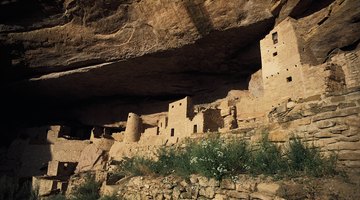How to Make Weatherproofed Mud Bricks
Mud brick, or adobe, is an old form of building material. Originating thousands of years ago, various methods have developed to make mud bricks less susceptible to the weather. One method is to coat the exterior and interior of the mud brick structure with a waterproof substance.

Another method, which weatherproofs the bricks themselves, involves mixing a stabilizer into the mud such as lime, asphalt or cement. Of these stabilizers, emulsified asphalt is the least complicated and least expensive.
Things You Will Need
- Asphalt emulsion
- Straw
- Wood
- Nails
- Hammer
-
Obtain asphalt emulsion from a hardware store and straw from a feed store.
-
Perform a soil test for making mud bricks. Instructions for testing can be found in the Resources section of this article. Conduct this test using the soil you are going to use to make the weatherproofed mud bricks. If the test determines that your soil needs more clay or sand, obtain that ingredient and mix the appropriate amount into the soil. Keep in mind that in the United States, adobe buildings must be made of 25 to 45 percent clay.
-
Decide on the size of bricks you want to make. Write down these dimensions on a piece of paper, and obtain the right size of wood. Also get nails and a hammer. Make a frame or frames of the desired dimensions. These frames are the brick molds.
-
Decide whether you want fully stabilized mud bricks or semi-stabilized mud bricks. Semi-stabilized bricks have approximately 2.5 percent to 6 percent emulsified asphalt while fully stabilized mud bricks have 5 to 12 percent asphalt. Fully stabilized asphalt works better in wetter climates than semi-stabilized asphalt, while semi-stabilized asphalt can be used instead of fully stabilized asphalt in drier areas.
-
On a warm, sunny day, gradually mix water into the soil to form a stiff but not crumbly mud that holds its shape when molded. Mix in the straw, using one part straw for every five parts of soil. Add the emulsified asphalt. Press the mud into the brick frames, smooth their tops and remove the frame and repeat.
-
Let the bricks dry for up to four days. Then stand the bricks up vertically on the small end and allow them to dry for approximately six weeks, depending on the weather. A brick is dry when it does not break apart when dropped from a height of two feet and is not scratched easily with a sharp object.
Tip
Do not plaster stabilized mud brick buildings. In parts of Latin America, cactus juice is fermented and mixed into the mud as a stabilizer.
Warning
Although it is known that asphalt releases gases that could harm people, no extensive testing has been done on the effects of asphalt emissions.
The Drip Cap
- Mud brick, or adobe, is an old form of building material.
- Another method, which weatherproofs the bricks themselves, involves mixing a stabilizer into the mud such as lime, asphalt or cement.
- Perform a soil test for making mud bricks.
- Instructions for testing can be found in the Resources section of this article.
- These frames are the brick molds.
- Mix in the straw, using one part straw for every five parts of soil.
References
- "The Natural House"; Daniel D. Chiras; 2001
- GreenHomeBuilding: Appropriate Mixes for Adobe
- "Adobe Houses for Today"; Laura Sanchez, Alex Sanchez; 2008
- KET Distance Learning: Birth of the City
Resources
Writer Bio
Joan Reinbold is a writer, author of six books, blogs and makes videos. She has been a tutor for students, library assistant, certified dental assistant and business owner. She has lived (and gardened) on three continents, learning home renovation in the process. She received her Bachelor of Arts in 2006.
Photo Credits
- Comstock/Comstock/Getty Images
- Comstock/Comstock/Getty Images
More Articles



